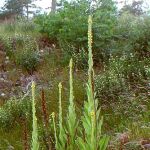| Common Name: |
Great Mullein |
| Other Names: |
Aaron's Rod |
| Botanical Name: |
Verbascum thapsus |
| Genus: |
Verbascum |
| Family: |
Scrophulariaceae |
| Native Location: |
W Europe; naturalized in N America |
| Cultivation: |
Well-drained to poor dry soil in sun. Verbascum thapsus self-sows freely in suitable conditions. Foliage is highly susceptible to caterpillars of the mullein moth. Subject to statuatory control as a weed in some countries, notably in parts of Australia. |
| Propagation: |
By seed sown in late spring or early summer; by root cuttings in late winter. May also be grown as an annual by sowing in early spring at 13-18°C (55-64°F). |
| Harvest: |
Leaves and flowers are collected in summer and dried for use in infusions, liquid extracts, and tinctures. Flowers may also be used fresh or frozen for use in infusions, medicated oil, and syrup. |
| Height: |
2m (6ft) |
| Width: |
1m (3ft) |
| Hardiness: |
Z5-9 |
| Parts Used: |
Leaves, flowers |
| Properties: |
A bitter, cooling, mucilaginous herb that soothes and lubricates tissues, promotes healing, and has diuretic, analgesic, expectorant, and antiseptic effect. |
| Tarot: |
Four of Swords |
| Medicinal Uses: |
Internall for coughs, whooping cough, bronchitis, laryngitis, tonsilitis, tracheitis, asthma, influenza, respiratory mucus, tuberculosis, urinary tract infections, nervous tension and insomnia. Externally for earache (flowers in olive oil), sores wounds, boils, rheumatic pain, hemorrhoids, and chilblains. Combines well with Marrubium vulgare (See, Horehound), Lobelia inflata, (See, Indian Tobacco), Tussilago farfara (See, Coltsfoot) for bronchitis, and with Thymus vulgaris (See, Common Thyme) for coughs. |
| Economic Uses: |
Leaves are smoked alone, or with Eriodictyon californicum (See, Yerba Santa) and Tussilago farfara (See, Coltsfoot), as a substitute for tobacco. |
| Bibliography: |
The Encyclopedia of Herbs by Deni Bown Copyright © 1995,2001 Dorling Kindersley Limited pg. 401 |

